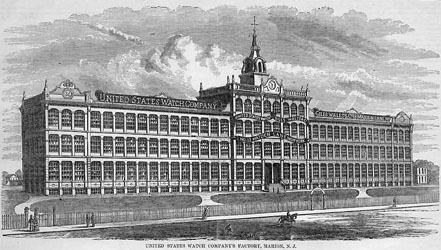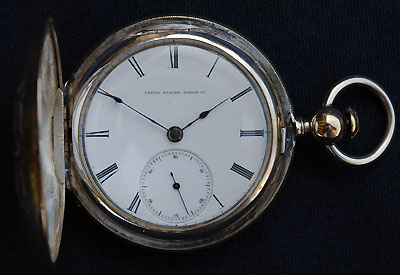United States Watch Co. Marion, New Jersey
 The United States Watch Company, Marion, New Jersey, was initially formed by Giles, Wales and Company, jewelers in New York City. The watch company was chartered in 1865, the five founding trustees were Frederick A. Giles, William A Wales, George C. F. Wright, Frank H. Page and Daniel Wells. Construction of machinery began at Dickinson & Rowden's machine shop in Newark, New Jersey under the supervision of James H. Gerry, Master Mechanic, formerly of the American Watch Company. A site at the northwest corner of Bergen Town, New Jersey, adjacent to the New Jersey Railroad line was selected, land purchased, and an impressive new four story factory building, with a cast iron and glass front was completed the following summer.
The United States Watch Company, Marion, New Jersey, was initially formed by Giles, Wales and Company, jewelers in New York City. The watch company was chartered in 1865, the five founding trustees were Frederick A. Giles, William A Wales, George C. F. Wright, Frank H. Page and Daniel Wells. Construction of machinery began at Dickinson & Rowden's machine shop in Newark, New Jersey under the supervision of James H. Gerry, Master Mechanic, formerly of the American Watch Company. A site at the northwest corner of Bergen Town, New Jersey, adjacent to the New Jersey Railroad line was selected, land purchased, and an impressive new four story factory building, with a cast iron and glass front was completed the following summer.
The first watch, a 18-size full plate movement, named the Frederic Atherton & Co, shipped in June 1867. The original model featured a butterfly opening which allowed viewing of the escapement and pallet action, simplifying adjustment. It was the first American made stem wind button set watch, 19-jewels, adjusted to heat, cold and positions, with serial numbers starting with 1001. A key wind version was also available. The Frederick Atherton & Co. was designed to compete with the finest watches then available and meet the requirements of railroad service. The second grade introduced was the Fayette Stratton, a moderately priced movement, named after Frederick Giles younger brother Fayette.
Damaskeening had become very popular in Switzerland where it was a trade secret. Damaskeening was seen as a way of upgrading the image of their watch. Fayette S. Giles was successful in recruiting F. Wilmot of St. Imier, Switzerland to travel to the United States to design and construct damaskeening machines for the United States Watch Co. By the end of Wilmot's one year contract in 1868 the art was learned and damaskeening became a feature of the United States Watch.
In February 1869 the company introduced the United States Watch Co. grade, a 18-size full plate lever movement, 19-jewels, butterfly opening, adjusted to heat, cold and positions and isochronism. It was the most expensive movement made in the United States at that time, available as either stem wind button set or key wind key set, in several variations with prices listing up to $450. In 1872 high quality 16-size, 1/4 plate and bridge, 19-jewel United States Watch Co. grade movements were introduced.
 The A. H. Wallis grade movement, a 18-size full plate lever movement, 19-jewels, butterfly opening, adjusted to heat, cold and positions and isochronism was also introduced in 1869. Also available as either stem wind button set or key wind key set, it was the second most expensive movement produced by the United States Watch Co. with prices between $114 and $199, and was similar to the United States Watch Co. grade. A 17-jewels version was introduced in 1871.
The A. H. Wallis grade movement, a 18-size full plate lever movement, 19-jewels, butterfly opening, adjusted to heat, cold and positions and isochronism was also introduced in 1869. Also available as either stem wind button set or key wind key set, it was the second most expensive movement produced by the United States Watch Co. with prices between $114 and $199, and was similar to the United States Watch Co. grade. A 17-jewels version was introduced in 1871.
In 1870 the company introduced the Henry Randel grade, a 18-size full plate lever movement, 15-jewels, butterfly opening, adjusted to heat and cold, as a more moderate priced movement with prices between $87.50 and $120.
By the end of 1869 there were 125 employees and 100 movements being turned out daily. In September 1871 the company had grown to 500 employees producing 200 movements per day. The firm manufactured 20 different grades of movements, in five movement styles, in 18-size, 16-size, 14-size and 10-size.
In 1873 15-jewels version of the the United States Watch Co grade was introduced with prices from $300 to $325, probably to compete with less expensive American Watch Company movements.
The United States Watch Co. struggled during the economic downturn which started in the Fall of 1873. Attempting to recover from financial challenges, the company was reorganized as the Marion Watch Company in 1874, and as the Empire Watch Company in 1876. The prices were reduced and less expensive grades were offered. Many of the watches the United States Watch Company had discarded, were recycled out of the reject bin and were completed. The factory ultimately closed permanently in 1877. The watch making equipment was sold to several different companies including the Auburndale Watch Company, the Howards of Fredonia, N.Y. and Hart, Sloan and Co. of Newark, N.J. The factory building subsequently housed several other companies, surviving until 1925. Today the street names Giles Ave., Wales Ave., Wright Ave., Wallis Ave., Fayette Place and Marion Place still survive, now part of Jersey City.
Railroad Grade Movements Produced:
- United States Watch Co. 18-size model 1 and 2, 16-size model 3 (19 and 15 J)
- A. H. Wallis, 18-size model 1 and 2, 16-size model 3 (19 and 17J)
- Frederic Atherton & Co. 18-size model 1 and 2, 16-size model 3 (19 and 17J)
- Henry Randel, 18-size model 1 and 2, 16-size model 3 (15 J)
- Fayette Stratton 18-size model 1 (15 J)
- Wm Alexander, 18-size model 1 (15 J)
- Marion Watch Co. 18-size model 1 (15 J)
- S. M. Beard, 18-size model 1 (15 J)
- John W. Lewis 18-size model 1 (15 J)
Note: The United States Watch Company, Marion, New Jersey. should not be confused with the United States Watch Company of Waltham, Mass.
References:
William Muir & Bernard Kraus, Marion - A History of The United States Watch Company, NAWCC Special Publication No. 1, Columbia, PA, 1985.
Roy Ehrhardt & William Meggers, Jr., American Pocket Watches: Identification and Price Guide Beginning to End...1830-1980, Heart of America Press, Kansas City, MO, 1987.
American Waltham Aurora Ball Columbus Elgin National Hamilton Hampden E.Howard Illinois Peoria Rockford South Bend Seth Thomas U.S.Marion U.S.Waltham
Sharing A Heritage Railroad History Train Technology Railroad Operation Railroad Time Museums & Heritage Railroads Railroads Today
